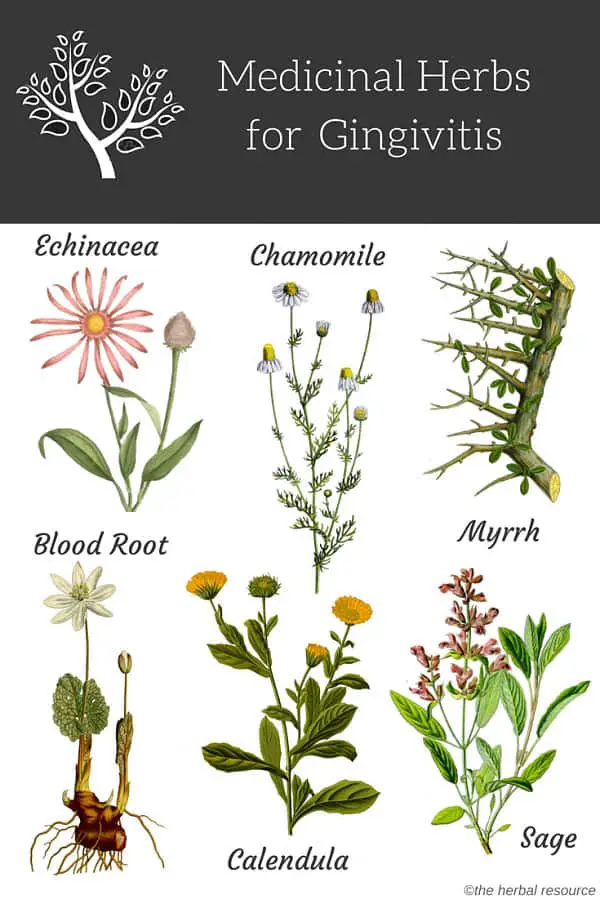Gingivitis is a very common infection of the surface tissue of the gum and may occur even when practicing good oral hygiene with proper brushing and flossing.
As the early stages of gingivitis are rarely painful and often presents minor symptoms, it is often overlooked.
However untreated gingivitis can degenerate into a serious infection that destroys soft tissue and eventually bone.
The herbs that are traditionally used in the prevention or treatment of gingivitis are chosen for their soothing, immune stimulating, anti-microbial or antiseptic actions.
Natural herbal remedies for gingivitis are often in the form of tinctures, which may be added to water or tea and used as a mouthwash.
Natural Herbs for Gingivitis
Echinacea (Echinacea angustifolia, Echinacea purpurea)
The immune-stimulating and antibacterial properties of echinacea make it one of the most important herbs for the treatment of gingivitis. It is also used to help soothe mouth ulcers and reduce gum swelling. Echinacea contains volatile oil, glycoside, echinaceine, and phenolics.
A drop or two of echinacea tincture to treat gingivitis can be added to teas and mouthwashes. It may cause a slight tingling of the tongue, but this effect is considered harmless.
Myrrh (Commiphora molmol, Commiphora abbysinica, Commiphora myrrha)
Myrrh is anti-microbial, astringent, carminative, anti-catarrhal, expectorant, and vulnerary. It is bitter, pungent and has a warming and stimulating effect.
The part of this plant that is used for herbal remedies is the gum resin, collected from the bushes in the arid regions of East Africa and Arabia. Myrrh contains volatile oil, resin, and gum. It has been cherished since antiquity for its powerful antiseptic and detoxifying qualities.
It is used in the treatment of infections of the mouth such as mouth ulcers, gingivitis, pyorrhea, and acts as a decongestant for the relief of pharyngitis and sinusitis.
As myrrh does not easily dissolve in water, it is best prepared as an infusion or tincture. If a stronger remedy is needed, a mixture of equal parts of tincture of myrrh and tincture of echinacea can be used.
Chamomile (Matricaria chamomilla, Matricaria recutita:) German; (Anthemus nobile): Roman or English)
The flowers are the part of the chamomile plant that is used medicinally and contains a volatile oil which includes chamazulene and isadol; mucilage; coumarin; and flavone glycosides.
Its actions are anti-spasmodic, carminative, anti-inflammatory, analgesic, antiseptic and vulnerary (used externally in the treatment of wounds). Its anti-inflammatory and antispasmodic effects stem from bisabolol, which is a component of the essential oil.
Chamomile (sometimes spelled camomile) is considered by European herbalists to be of equal effectiveness to a commercial gargle or mouthwash when used as a treatment for gingivitis. Chamomile may be used to prevent gingivitis by preparing a strong chamomile tea to be used as a mouthwash or drunk as a tea.
Blood Root (Sanguinaria canadensis)
Bloodroot was traditionally used by Native Americans as an oral antiseptic. The dried rhizome is the part of the plant that is used medicinally.
Bloodroot contains alkaloids including sanguinarine, chelerythrine, protopine, and homochelidine; red resin, citric acid, and malic acids. The compound sanguinarine is found in the red root that gives this plant its name. This compound is used in a few commercial oral hygiene products and is known for its ability to prevent bacteria from forming plaque.
Bloodroot acts as an expectorant, anti-spasmodic, emetic, cathartic, antiseptic, cardio-active, and topical irritant.
Well designed studies have shown toothpaste containing sanguinarine to be moderately effective against several types of oral bacteria, and that it will reduce the amount of dental plaque within eight days of beginning the use of the toothpaste containing sanguinarine.
Sage (Salvia oficinalis)
Sage has a long history in European herbal medicine as the classic herbal remedy for gingivitis, as well as inflammations of the mouth, throat, and tonsils.
Sage is carminative, antispasmodic, antiseptic, and astringent. Sage contains volatile oil including thujone, cineole, linalol, borneol, camphor, salvene and pinene; a bitter; tannins; triterpenoids; flavonoids; estrogenic substances, and resin.
Its volatile oils are soothing to the mucous membranes, and it may be used as an herbal remedy internally and externally as a mouthwash for gingivitis. It is also is an excellent herbal treatment for mouth ulcers.
In European herbal tradition, sage leaves are rubbed on the gums and teeth as a stimulant dentifrice.
Sage tea is prepared as an herbal remedy for gingivitis by pouring a cup of boiling water over two or three teaspoons of dried sage and steeping for several minutes.
Some other natural herbs that have been used to treat gingivitis.
- Eucalyptus (Eucalyptus spp)
- Calendula (Calendula officinales)
- Peppermint (Mentha piperita)
- Rhatany (Krameria lappacea)
- Cranberry (Vaccinium macrocarpon)
- Borage (Borago officinales)
- Grapefruit Seed Extract (Citrus x paradisi)
- Mustard oil (Brasscia alba; Brassica nigra)
- Neem Leaf Extract (Azadirachta Indica)
- Knotgrass (Polygonum aviculare) – also known as Mexican Sanguinaria
- Gotu Kola (Centella asiatica)
- Pomegranate (Punica granatum )
- Stinging Nettel (Urtica dioica)
- Bistort (Bistorta officinalis)
The Use of Medicinal Herbs for the Treatment of Gingivitis
Herbal remedies should never replace proper dental care. Always inform your dentist of any herbal treatments that you are using.
While chamomile and calendula have a very long history of use as medicinal herbs, any preparation that includes these members of the aster family should be used cautiously with people who are allergic to ragweed pollen, asters, or chrysanthemums.
Some people will have an allergic reaction to chamomile, calendula, chrysanthemum or aster, whether drunk as a tea, used as a mouthwash, in a diffuser, or applied topically as an essential oil, in shampoo, lotion or cosmetic product.
Thordur Sturluson
Latest posts by Thordur Sturluson (see all)
- What is the Difference Between Hemp and Marijuana? - June 3, 2019

Leave a Reply